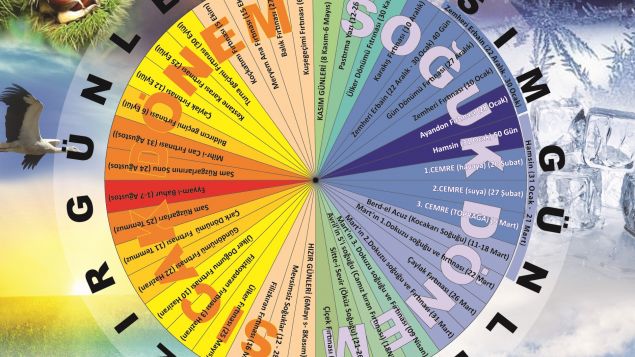

What is Cemre? How Does Cemre Fall?
The third of Cemre (warm increases supposed to fall from sun into air, water, and earth in February) is known as the heralds of spring fell to the ground on March 6th. It is believed that Cemre’s are the indications of 'the increases in temperature'. A word of Arabic origin, Cemre means "glowing fire". Cemre in the folk calendar, based on observations of long-standing weather events, is seen as the first sign of the increase in temperature.
Cemre’s, firstly fall to air, secondly to water, and then to soil every seven days.
Scientifically, meteorologists give the following information about Cemre: ''On a clear day, the solar energy passing through the lower layer of the atmosphere, is absorbed by the surface of the earth. So the earth surface gets warmer. As the air on the surface heats up, it becomes less dense than the air in the high altitude. The warmer air rises, and the colder air collapses. Rising air expands and cools. The water vapor concentrates in the form of cloud droplets, allowing the air to heat up due to the change of state heat.”
Folk Calendar, Agriculture and Animal Husbandry
Folk Calendar is an old calendar that is originated from Anatolia centuries ago. In forecasting and planning, regularly repeated natural phenomena and cyclical life flows of animals and plants inspired mankind. Thus, the people's calendar was formed and mankind systematized the vital foresight and planning practice. Not complying with the folk calendar, the product of long-term experience and knowledge, and not acting in the direction that it leads, may cause the individual to suffer damages. This calendar has a vital importance for the people who are engaged in agriculture and animal husbandry.
In the folk calendar, the old people divided 365 days into two as "November" and "Khidr". November was 179 days and Khidr was 186 days. November part of the year, the winter period, starts on November 8th and lasts until May 6th. On May 6, the summer period, the days of Khidr, starts together with Hıdırellez. The name of November means "divider" in Arabic. This name was given because it divides the year.
November is considered as New Year according to the calendar of the farmers, income and expenses of the previous year are closed, the book of the new year is opened.
The first 135 days of November are the most severe period in winter and the necessary measures are taken by people. Starting from the 46th day of November, "Erbain" cold weather starts and lasts forty days (Arabic "40" days of winter). Immediately after the day when Erbain ends, that is, from the 86th day of November, "Hamsin" cold weather (Arabic "50" days of winter) comes. These cold midwinter days are called Zemheri. Thus, ninety days of the coldest times of winter pass, and in the Folk Calendar, on the nineteenth day after the beginning of November (February 5/6) the earth begins to revive.
Late in November, when it is the right time to leave behind the tough winter days, soil should be digged up, ventilated and plows should be drived. (February 15/ 16)
 The periods of Cemre, can be detalized as below;
The periods of Cemre, can be detalized as below;
Khidr days starts in 6th May and continues until the evening of 7th November. This period is summer. The traditional spring festival that begins on May 5th and ends on May 6th in Anatolia is celebrated as Hıdrellez Day. For farmers, it is considered the second new year of summer works.
At the end of spring and at the beginning of summer, 40 days (mid-afternoon) rain are seen. These are the last rains of the spring that are likely to happen in the mid-afternoon throughout 40 days. It took this name because it rains in the mid-afternoon when the temperature difference is highest. After the rainy weathers, the air smells like earth and agriculture is determined according to these rains.
The 48th day of Khidr (June 21) is the longest day, on the 141st day of Khidr (September 21) the night and the day becomes equal.
Ninety of Summer (August 5) is the middle of the summer. This period refers to the hottest days, and they are are called 'Eyyâm-ı Bâhûr' in the public calendar. The simoon, who breezes by hitting the people like a flame, is specific to these days. The shepherds try to keep their herds in shady places in these days.
Fertile Days to All Producers
Agriculture, one of the earliest production activities of human history, has been an important stage in humanity's settlement on the soil, the establishment of civilizations and the economic process. Our farmers, who have contributions to the every stage of the development of our country, the growth of our economy, increasing the production and the productivity, agricultural production, are always held in high esteem. We wish fertile harvests for all the farmers who have contributions to every stage of agricultural production. Çamlı Feed Animal Husbandry Co. always support our farmers who are making sacrifices to produce the best vegetables, fruit, grain and animal products with their great efforts in spite of all kinds of difficulties. We wish their products to bring various profits.
Register to our newsletter in order to be aware of our announcements and news.
